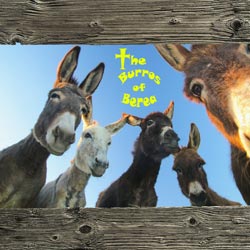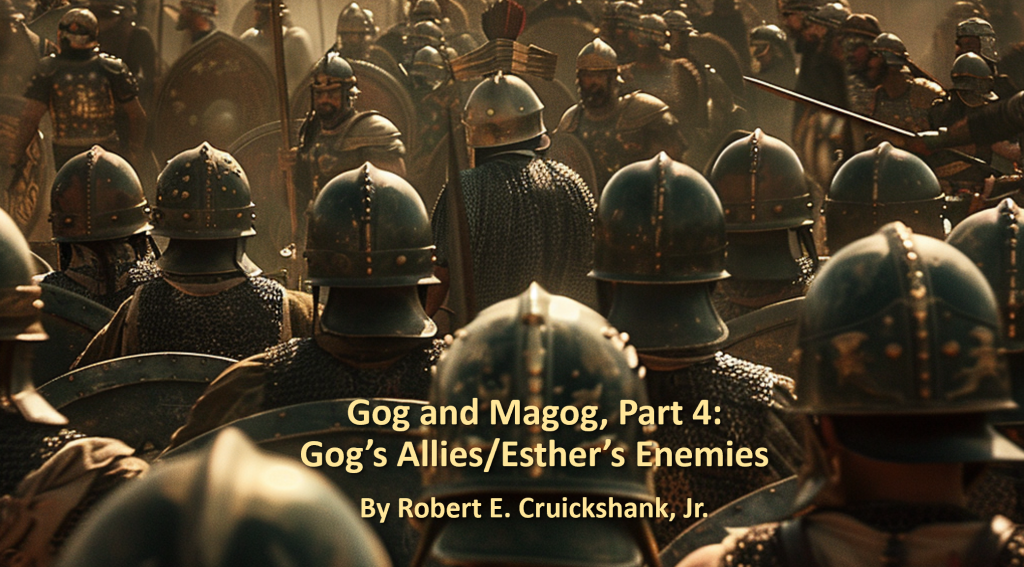Gog and Magog, Part 4: Gog’s Allies and Esther’s Enemies
Copyright © Robert E. Cruickshank, Jr. (February 23, 2024)
All Rights Reserved
“Persia Cush, and Put are with them, all of them with shield and helmet; Gomer and all his s hordes; Beth-Togarmah from the uttermost parts of the north with all his hordes— many peoples are with you. Be ready and keep ready, you and all your hosts that are assembled about you, and be a guard for them” (Ezekiel 38:5-7).
In the previous installment, it was pointed out that Ezekiel is describing an ancient battle that was fought with ancient weapons. Gog’s hordes would attack on horseback, wielding swords, war clubs and spears. They’re not flying fighter jets and dropping nuclear bombs. In verses 5-7, Ezekiel identifies Gog’s allies – Persia, Cush, Put, Gomer, Beth-Togarmah. Fittingly, the nations that fought with these ancient weapons were ancient nations. It only makes sense. Ezekiel’s audience didn’t need to look 2600 years into the future to understand what or who he was talking about. But we need to look 2600 years into the past to understand it.
Rosh = One Too Many
In the second article in this series, we noted how Dispensationalists take Rosh (the Hebrew word for chief, beginning, or source) and argue that it is a place name rather than an adjective modifying the word prince, i.e., “chief prince.” They then proceed to argue that Rosh sounds like “Russia,” and the whole prophecy is about Russia, Russia, Russia. This is the “Russian Hoax” when it comes to Bible prophecy. Aside from the reasons given in that second article, Ezekiel’s list of nations in verses 5-6 is further evidence that Rosh is not a place name or distinct nation.
In these verses, we have five nations plus the other two previously mentioned (Meshech and Tubal), for a total of seven nations aligning themselves with Gog. If Rosh was also a nation (rather than an adjective modifying the noun prince), it would insert an eighth nation into the text and run completely counter to Ezekiel’s literary style.
There are seven of everything. The weapons left behind are burned for seven years (39.9). It takes seven months to bury the dead (39.12, 14). The dead are designated as seven different types of carcasses for the wild animals to feast on after the battle (39.18). God hurls seven judgments against Gog (38.21–22). On two occasions, seven terms are used to designate the enemy’s war gear (38.4–5; 39.9). Seven times, the formula “thus saith the Lord” is used (38.3, 14, 10, 17; 39.1, 17, 25). And there are seven variations on the theme of the nations recognizing Yahweh’s greatness (38.13, 23; 39.6, 7 [twice][1], 22, 28).
And this follows Ezekiel’s overall, larger literary pattern as a whole. As Daniel Block notes: “The number of allies totals seven, exactly the same number as had been addressed in the collection of oracles against the nations (chs. 25-32), and those who accompany Egypt in Sheol (37:17-32). Given the prominence of the number seven in the present oracle, this must be intentional.”[2]
As most all scholars recognize, Ezekiel’s usage of the number seven is a literary technique that he uses to indicate the scope of the crisis, the vast size of the conflict, and the magnitude of the victory of God’s People.[3] Thus, besides the reasons already mentioned in my second article, Rosh as a separate people group or nation just doesn’t fit. On top of everything else, that would be an eighth nation. And this is completely out of sync with Ezekiel’s literary pattern.
Name That Nation
What the Dispensationalists do next, with this list of nations, is completely out of sync with the principles of interpreting the Bible in its historical context and in terms of audience relevance. They try to match these ancient place names up with their modern-day counter parts. But anybody can play this game. The geography of the world hasn’t changed. But, what’s really funny is how their ancient to modern identifications always change with the latest news headlines. Back in the day, they all said that Gomer was modern-day Turkey.[4] But in 2022, Gomer suddenly became Ukraine.[5]
When you keep the Bible in its original context, you don’t need to keep changing the identities of these place names, turn horses into helicopters, or bows and arrows into missiles and rocket launchers. The text only has to be relevant to the people of that time period. And, indeed, these place names were. As Gary DeMar writes:
“Ezekiel 38:5–6 tells us that Israel’s enemies come from ‘Persia, Cush, and from the remote parts of the north,’ all within the boundaries of the Persian Empire of Esther’s day. From Esther we learn that the Persian Empire ‘extended from India to Cush, 127 provinces’ in all (Esther 8:9). Ethiopia (Cush) and Persia are listed in Esther 1:1, 3 and Ezekiel 38:5: ‘Persia, Ethiopia and Put with them, all of them with shield and helmet.’ The other nations were established in the geographical boundaries ‘from India to Ethiopia’ in the ‘127 provinces’ over which Ahasueras ruled (Esther 1:1). ‘In other words, the explicit idea that the Jews were attacked by people from all the provinces of Persia is in both passages,’ and the nations listed by Ezekiel were part of the Persian empire of his day. The parallels are unmistakable.”[6]
DeMar makes a subtle but important point here that might be easy to miss. These were nations that were part of the Persian empire of Ezekiel’s day. But Persia wasn’t the major power player yet when Ezekiel wrote. It was still Babylon. That’s where he and his readers were in exile. Why is Ezekiel focusing on Persian nations when Babylon was his audience’s primary and immediate concern?
This leaves commentators perplexed. For example, Daniel Block notes: “…in Ezekiel’s time the Persians were still a relatively unknown people on the fringes of the Israelite consciousness, hence qualifying” for, what he calls, a “mysterious context.”[7] Later he makes the point again that “…the names listed all represent distant peoples, from the fringes of Israelite awareness.”[8] Likewise, Sverre Boe seems equally baffled, writing: “…these were all countries with which Israel never in her actual history came to fight a war. Israel’s historical enemies are all absent from this list.”[9]
When we understand that Ezekiel’s prophecy finds its fulfillment during the time of Esther, there’s nothing puzzling about this at all. The fact that Ezekiel lists only nations that were already in the province of Persia, when he wrote from Babylon, means he’s telegraphing to his readers that the attack would come from the next empire to rise to power, i.e., Persia. And that’s exactly what happens in Esther. Ezekiel is like a magnet drawing us to the book of Esther and vice versa. Scripture interprets Scripture, and there is no need to look beyond the text of Scripture itself to find the fulfillment of Ezekiel 38 and 39. There is no need to look beyond the book of Esther.
Having said that, our next installment will look to verses 8-9, which show us exactly where to look to find this fulfillment.
_________________________________________________
[1] His holy name will no longer be profaned, and the nations will know that He is the Lord.
[2] Daniel I. Block, The Book of Ezekiel: Chapters 25-28 (Grand Rapids, MI: William B. Eerdmans Publishing Company, 1998), p. 441.
[3] See: William Tooman, Gog of Magog: Reuse of Scripture and Compositional Technique in Ezekiel 38–39 (Tübingen, Germany: Mohr Siebeck, 2011), p. 150.
[4] Woods, Andy. The Middle East Meltdown: The Coming Islamic Invasion of Israel (p. 16). Dispensational Publishing House. Kindle Edition.
[5] Has biblical Gog and Magog war begun? – The Jerusalem Post (jpost.com)
[6] The Gog and Magog End-Time Alliance: Israel, Russia, and Syria in Bible Prophecy (Powder Springs, GA: American Vision Press, 2016), p. 56.
[7] Daniel I. Block, The Book of Ezekiel: Chapters 25-28 (Grand Rapids, MI: William B. Eerdmans Publishing Company, 1998), p.439
[8] Ibid., p. 441.
[9] Sverre Boe, Gog and Magog (Germany: Mohr Seibeck, 2001), p. 310.



